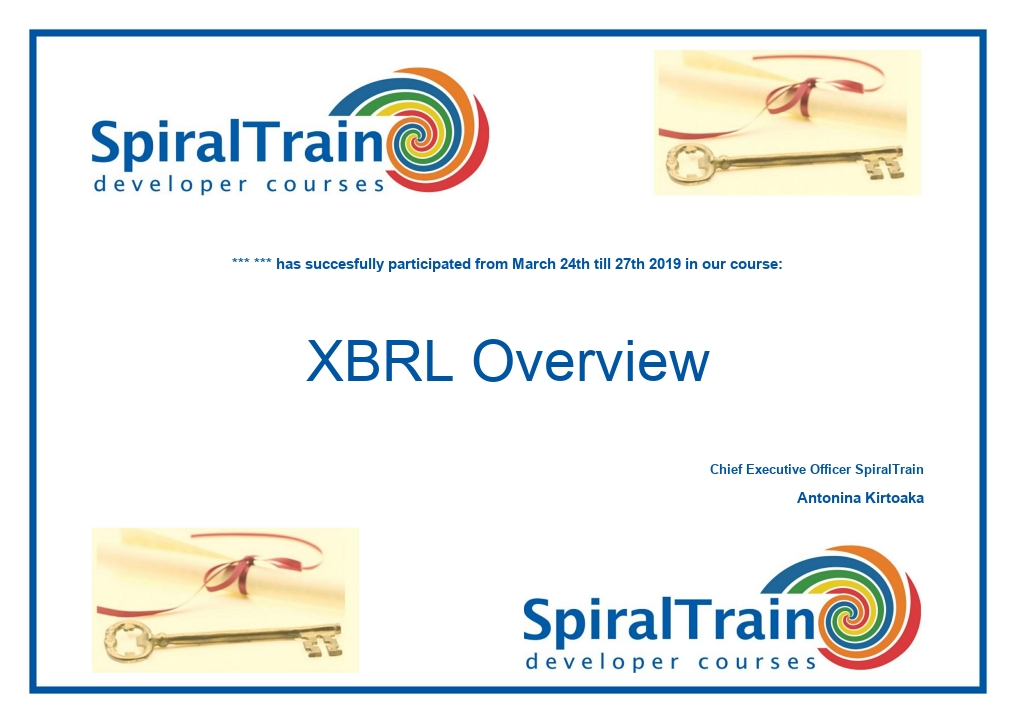-
Learning by doing
-
Trainers with practical experience
-
Classroom training
-
Detailed course material
-
Clear content description
-
Tailormade content possible
-
Training that proceeds
-
Small groups
The course XBRL Fundamentals covers the basic concepts of the Extensible Business Reporting Language (XBRL). XBRL is an XML vocabulary that is used for the exchange of financial data and the preparation of financial reports.
The foundations of XBRL are based on XML standards such as XML Schema, XLink and XPointer and the essentials of these standards are discussed. The preparation of an XBRL taxonomy in the form of an XML Schema is also discussed.
In this context we should actually speak of a Discoverable Taxonomy Set consisting of various XML Schemes and linkbases in the form of XML files with meta information.
The course covers how draft reports can be converted into XML tags and how meta-information is assigned to these tags. The various linkbases for labeling, presenting and referring information are discussed. And also the calculation linkbase with which simple business rules can be enforced is treated.
Attention is also paid to XBRL instance documents, the specification of numerical contexts and attributes and the representation of data in more dimensions.
Finally some applications of XBRL will be discussed as well as a.o. the extensibility of XBRL with more complex business rules in the XML Formula linkbase.
The course XBRL Fundamentals is intended for developers, IT staff and financial specialists who must learn to read and understand XBRL documents.
To participate in the course XBRL Fundamentals knowledge of the basic syntax of XML is required.
The theory is discussed on the basis of presentation slides. Demos are used to clarify the theory. There is ample opportunity for practical exercises. The course material is in English.
Participants receive an official certificate XBRL Fundamentals after successful completion of the course.

Module 1 : XBLR Intro |
Module 2 : Taxonomies |
Module 3 : Linkbases |
|
What is XBRL? What is XML? XML versus XBRL XLink and XPointer Benefits of XBRL Taxonomy and Instance Extension Taxonomies XBRL Specifications Financial Reporting Overview GAAP and IFRS Legacy Reporting Workflow Single Source of Data XBRL Business Report |
What are Taxonomies? XBRL Taxonomy Standards Taxonomy Parts Schematic Overview Taxonomy Selection Taxonomy Schema Concept Definitions Item Data Types XML Schema Data Types Taxonomy Elements Concept Attributes Taxonomy Relationships Linkbases References |
What are Linkbases? Characteristics of Linkbases Roles and Arcroles Label Linkbase Language Support Label Linkbase Roles Reference Linkbase Reference Linkbase Roles Calculation Linkbase Calculation Relations Concerns Definition Linkbase Definition Linkbase Roles Presentation Linkbase |
Module 4 : Instance Documents |
Module 5 : Dimensions |
Module 6 : XBRL Modules |
|
Instance Documents XBRL Root XBRL Root Attributes Facts Items and Tuples Contexts Context Entity Context Period Context Scenario Context Examples Units Editing Default Units Validation |
Mapping Intro Multidimensional Model Pivot Tables Mappping Dimension Values Mapping Context Mapping Facts Mapping Footnotes Complete Mapping Options and Properties Functions and Filters Hypercubes Types of Hypercubes Editing Hypercubes |
Extending XBRL Taxonomy Types XBRL Formula Formula Linkbase Using XPath Binding Variables Value Expressions Calculations Results Standard Predicates Equality Testing Inline XBRL XBRL Versioning XBRL Table Linkbase |
